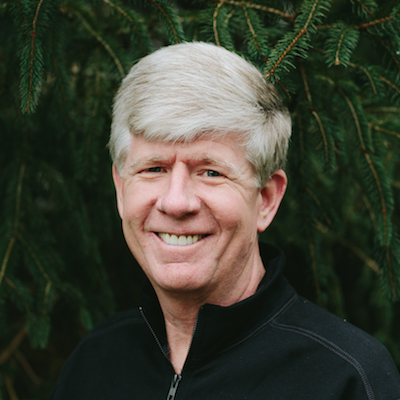Every organization I’ve ever been involved in, the ones I’ve owned or the ones I’ve consulted with, whether it be a business, a school, a family, a government, or a church, every single one has had four distinct groups of people. When you can really understand those four groups and how they impact the organization, it’s much easier to know how to deal with them.
The Inner Core
Picture a series of concentric circles with me, three circles surrounding a center circle. That first group in an organization is at the very center of the circles and is the one we call the inner core. Typically, you would call that the management team, the leadership team. The inner core only exists after the organization gets to stage three of the organizational models.
This stage three is called the Functional Responsibility Model, a combination of the first two organizational models of Command/Control with top down leadership and Servant Leadership with bottom up leadership. As these two models move toward more effective leadership, they change. The leader of the command/control group still maintains their leadership position, but has become the one responsible for casting vision for the organization, so we call this new leadership style the Visionary Model. The Servant Leadership Model has become an organizational model where the leader still serves, but now intentionally serves the organization through teaching, training, and equipping its members. If we take those two organizational models, the Visionary Model and the Servant Leadership Model, and combine them to make what we call the Functional Responsibility Organizational Model, we have leaders and departments fulfilling specific functions but with strong and increasing relationships that fundamentally connect the various roles and responsibilities of the organization through those relationship.
Your organization needs to be at least a stage three organizational model in order to have an inner core. If your organization is still in the more common command/control or servant leadership, you can’t really have an inner core because the other three groups encircling that inner core center circle are still part of the organization and still need to be dealt with.
What is that inner core group? What does it mean to be in that group? It means everybody on that team has bought into the vision. The vision is clear and everyone is saying they’re grabbing on to this vision and they’re going after it together. And that is a fantastic place for an organization to be.
The Core
Now let’s talk about those other three groups in any organization. Surrounding that inner core circle is another circle called the core. This group may not be in those management meetings. They may not be in all the vision meetings, but they are totally bought in. More than likely, they report to someone who is in the inner core. But this group of people is totally bought in. They are committed. The problem is there are two other groups in every organization I’ve ever seen.
The Lean-Inners
The first potential trouble group are the lean-inners that reside in a circle around the core. They are looking in, and they are saying, “Wow! I think I want to be a part of that.” But for some reason, they’re not quite ready to jump all in, not quite ready to fully commit. Why is that? Maybe it’s a hippocampus issue. Maybe they are thinking they have seen all this before, and they’re not quite convinced enough to get fully involved. Maybe it’s something else. Maybe it’s a trust issue, and they need a little more trust before they say they’re all in, but they’re thinking about it.
The Lean-Outers
Now, this lean-inner group is not a huge problem, except for the fourth group, the last circle of people encircling all the other circles. That group is the lean-outers. They are the ones who have no intention of ever getting in. They’re the ones who always stand out, pull the hand grenade, and toss it into the middle of the organization and its workings. Why do they do that? Because right now, they control the culture, and they don’t want to give up their control.
The Connection Between Lean-Inners and Lean-Outers
If you remember, I have shared with you before that I have some really good news for you: It only takes 3-15 percent of any organization to shift the culture. I also told you I have some really bad news: It only takes 3-15 percent of an organization to control the culture. So every organization has to make a decision about which 3-15 percent is controlling the culture. The problem is, many times, the lean-outers are your highest performers. That’s why we as leaders have to deal with this group because the last thing we want is for the lean-inners to join the lean-outers. If the lean-inners don’t trust that the inner core and core are going to deal with the lean-outers, they won’t go ahead and lean in and join our core. In fact, I can tell you that if you allow a lot of lean-outers to stay in your organization, the lean-inners will join the lean-outers.
Have you ever noticed that most organization write almost all of their human resources policies and procedures manuals based on the lean-outers. Does that make much sense? As leaders, we have to lean the lean-outers on out or lean them in. In other words, we’re going to make it their choice. Get on board or maybe there’s a better place for you somewhere else. The good news is when we remove the lean-outers, the lean-inners then jump into the core because they see they can trust that the leaders won’t allow the lean-outers to continue behaving that way.
Think about the positive impact on an organization that has almost no lean-outers and a lot of inner core and core. I argue the result would be higher profits and better relationships, so, as transformational leaders, we have to decide what we do with this information, how to deal with these groups in our organization, and how to use the tools that deal with the lean-outers. We have those tools, and in Part 2 of this subject I’ll share with you just exactly how to do that.
Ford Taylor is a leadership strategist, keynote speaker, and the author of Relactional Leadership. As the Founder of Transformational Leadership, he is known as a man who can solve complex business issues, with straightforward practical solutions, while maintaining his focus on people.



